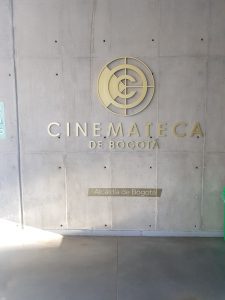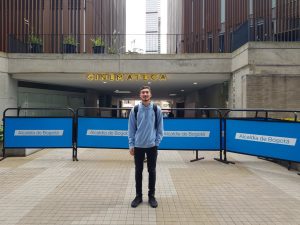 La inauguración de la nueva cinemateca de Bogotá
La inauguración de la nueva cinemateca de Bogotá
Con la ambición fuerte de mejorar mi nivel de español en cualquier manera que fuera posible, y con ganas de conocer más sobre Colombia y el continente de América Latina a través del cine, me puse muy feliz al enterarme de la reciente inauguración de la cinemateca de Bogotá, la cual queda a la vuelta de la esquina de mi vivienda universitaria en la carrera 3ª con calle 19. La nueva cinemateca se inauguró el 13 de Junio y alberga 3 salas de proyección, la más grande llamada la ‘Capital’ con un foro de 272 personas .
Aproveché este gran complejo de vanguardia durante el mes de Julio y entre las películas que vi, las mas destacadas fueron ‘Los reyes’ (Bettina Perut, Iván Osnovikoff, 2018 ) y ‘Temblores’ (Jayro Bustamante, 2019). Los reyes’ se enfocó en dos perros del skatepark más antiguo de Santiago de Chile, pero a través de voces fuera del cuadro, la película contó historias cómicas y tristes de adolescentes marginales, así que logró que fuera muy emocionante tanto a nivel social como animal. Por otro lado, ‘Temblores,’ de Jayro Bustamante, contó la historia de un padre guatemalteco expulsado de su familia al descubrir su homosexualidad. Después de ver la película, asistí una discusión de panel con el director y me atreví a plantear una pregunta sobre los desafíos de grabar una película queer – ¡Bustamante me contestó que lo más difícil era grabar escenas de coito homosexual con dos actores heterosexuales! A partir del 1 de Agosto en el ‘Ciclo Rosa’ habrá una selección queer del Berlinale 2019, con el objetivo de abrir ‘un espacio para revisar temas como sexualidad y género desde una perspectiva abierta y crítica,’ según Juliana Restrepo, directora del Instituto Distrital de las Artes (Idartes).
Además de la amplia gama de películas contemporáneas y estrenos colombianos (‘Homo botanicus,’ ‘El piedra’), la cinemateca dedicó su temporada inaugural a los clásicos del cine latinoamericano, incluso ‘Memorias del subdesarrollo’ (Gutiérrez Alea, 1968) que narra la revolución cubana desde la perspectiva del protagonista narcisista y voyerista, Sergio. Estas películas clásicas confirman un aspecto importante de la cinemateca: preservar el acervo cinemático del país y continente. La cinemateca no es solo una sala de cine, sino más bien una cuna de la memoria fílmica, y según Paula Villegas, gerente del Idartes, es ‘un espacio donde se siente…la energía de lo que ha pasado.’ Más allá de su selección de películas, el propósito archivo de la cinemateca se manifiesta en su biblioteca donde académicos, estudiantes y miembros del público pueden encontrar ‘un punto de consulta para sus investigaciones.’ De hecho,la nueva cinemateca cuenta con colecciones que superan 50.000 unidades bibliográficas, hemerográficas, fotográficas, iconográficas, gráficas, sonoras y audiovisuales. La entrada de la biblioteca es gratis, y eso representa la accesibilidad de la cinemateca, ‘un espacio para todos,’ según Juliana Restrepo. Los boletos para películas son baratos ($5.000 para el tiquete general y $4.000 para adultos mayores y estudiantes) y hay una gama de actividades, discusiones y talleres gratuitos. Además, es evidente que la nueva sede ha sido diseñada para tener en cuenta a las familias, pues hay un parqueadero subterráneo y una sala juvenil que se llama la ‘objetoteca’ en la cual ocurrirán talleres de creación e ideas. También existe el Salón Rayito para niños entre los 0 y 5 años, que busca el desarrollo de actividades de exploración con imagen y sonido. La arquitectura del edificio también reafirma que la cinemateca no es un espacio exclusivo, ni un punto de encuentro solo para la intelligentsia del mundo del cine: debido a planificación prudente, el edifico se integra con el espacio público de la ciudad y su arquitectura abierta ofusca las fronteras entre fuera y dentro. Por eso, la nueva cinemateca, en poco tiempo, se ha convertido en un referente de la ciudad y ha logrado su propósito de ‘vincular al público y fortalecer esa relación de los ciudadanos con las artes audiovisuales,’ según Paula Villegas.
Sentado en la antigua cinemateca de Bogotá en 2013, el difunto cineasta Abbas Kiarostami afirmó que ‘lo primero que hago cuando llego a una cuidad es buscar su cinemateca o una biblioteca. Esos lugares son las embajadas se una patria.’ Si el director mediático iraní tiene razón, la nueva cinemateca no solo representa la amplificación de la producción cinematográfica de Colombia sino también la consolidación de Bogotá como el epicentro cultural del país y continente.


The Inauguration of the New Cinemateca de Bogotá
With a strong ambition to improve my Spanish in whatever way possible, and with a desire to learn more about Colombia and Latin America through cinema, I was delighted to learn of the recent inauguration of the Cinemateca de Bogotá, a cinema and public film archive located a stone’s throw from my university accommodation on carrera 3ª,calle 19. The new cinemateca was inaugurated on the 13thof July and houses 3 screening rooms, the largest of which is called ‘La Capital’ with a capacity of 272 people.
I made the most of this avant-garde facility throughout the month of July and the most notable of the films which I saw were ‘Los reyes’ (Bettina Perut, Iván Osnovikoff, 2018 ) and ‘Temblores’ (Jayro Bustamante, 2019). Los Reyes centred on two dogs living in Santiago’s oldest skate park, but through the use of off-screen voices, the film told comic but sad stories of peripheral youths, making the film moving on both animal and social levels. On the other hand, Bustamante’s ‘Temblores’ told the story of a Guatemalan father expelled by his family upon discovering his homosexuality. After the film, I attended a panel discussion with the director and plucked up the courage to ask a question (in Spanish!!) about the challenges of filming a queer film. Bustamante replied that the most difficult thing was filming gay sex scenes with two straight actors! From 1st August, in the cinemateca’s ‘Ciclo Rosa,’ there will be a selection of queer films from this year’s Berlinale, with the objective of opening ‘a space to consider issues relating to gender and sexuality from a critical and open perspective,’ according to Juliana Restrepo, director of the Instituto Distrital de las Artes (Idartes).
In addition to the wide range of contemporary films and Colombian premières (‘Homo botanicus,’ ‘El piedra’), the cinemateca dedicated its first cycle of films to Latin American classics, including ‘Memorias del subdesarrollo’(Gutiérrez Alea, 1968) which narrates the Cuban Revolution through the perspective of its voyeuristic, narcissistic protagonist, Sergio. These classics reflect an important aim of the cinemateca: to preserve the cinematic heritage of country and continent. The cinemateca isn’t only a cinema, but also a cradle of filmic memory, and according to Paula Villegas, manager of Idartes, it is ‘a space where one feels the energy of what has passed.’ Beyond its selection of films, the archival function of the cinemateca is manifested in its library, where students, academics and members of the public can find a point of consultation for their research. In fact, the new cinemateca houses over 50,000 bibliographical, periodical, photographical, iconographical, graphical and audio-visual resources. Entrance to the library is free, making it accessible, and thus supporting Juliana Retrespo’s claim that the cinemateca is ‘a space for all.’ Ticket prices for the films are cheap, COL $5,000 (£1.25) for a standard ticket or COL $4,000 (£1) for students and the elderly, and there are a range of free activities, discussions and workshops. Moreover, it is clear that the new headquarters has been designed with families in mind – it has a basement car park and a children’s room called the ‘objetoteca’ which hosts creative workshops. There is also the Salón Rayito for infants, which hosts sound and image exploration activities. The architecture of the building also makes it clear that the cinemateca isn’t an exclusive space or simply a meeting point for the intelligentsia of cinema: due to careful planning, the building is integrated with the public space of the city and its open plan architecture obfuscates the boundaries between outside and inside. For this reason, the new cinemateca, in a short space of time, has become a reference point of the city and has achieved its aim of ‘strengthening the relationship between Bogota’s citizens and the audio-visual arts,’ according to Paula Villegas.
Sat in the old Cinemateca de Bogotá in 2013, the now deceased filmmaker Abbas Kiarostami stated that ‘the first thing I do when I arrive in a city is look for its cinemateca or a library. Those places are the embassies of a country.’ If the famous Iranian director is right, the new cinemateca not only represents the broadening of Colombia’s cinematographic production, but also the consolidation of Bogota as the cultural epicentre of the country and the continent.
